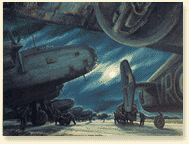

"Marshalling of the Hallies." Painted in 1947 by Paul Goranson (1911-).
Handley-Page Halifax heavy bombers prepare for take-off on one of their countless night-time raids over Germany.
The Beaverbrook Collection of War Art |
The Bomber Offensive
After the fall of France in 1940, the British were left with few
ways to strike back at Germany. One was the bombing of German
cities, workers and industry. Because of the strong German fighter
defence, the 's bombers could operate only at night. At first,
results were poor and losses of aircraft heavy. Through 1942 and
1943, however, new four-engined heavy bombers with much greater bomb
loads, improved radio and radar aids to navigation and better
training greatly improved
Bomber Command's efficiency. It was always, though, a blunt,
brutal weapon, killing large numbers of civilians and destroying
their homes.
The heavy bombers of the U.S. Army reached England in
1942 and began to bomb Germany by day. The Americans went after individual
industries using formations of heavily-armed bombers, and lost
heavily to German day fighter attacks, particularly before they
developed a long range escort fighter. In July 1943, a series of
British and American raids created a firestorm which consumed the
city of Hamburg, killing some 30,000 inhabitants, most of them women
and children.
The bombing killed some 600,000 German civilians, but did not
succeed in breaking their morale. German war production fell
drastically only at the very end of the war. Forever gone, though,
were many of the cultural treasures of Europe, works of art
destroyed by Allied bombs.
RCAF bomber squadrons formed a major part of Bomber Command, and
even more RCAF aircrew served in bomber squadrons. In January
1943 the squadrons were brought together to become No. 6 (RCAF)
. In its first year of service, the suffered staggering
losses, particularly in the long-range raids of the Battle of Berlin
in the fall and winter of 1943-1944. In all, over 8,200 Canadian
aircrew in Bomber Command died.
Related Newspaper Articles
English Articles
- London Denies That Bombs Were Dropped on Non-Military Objectives
- Berlin Threatens to Return "Bomb For Bomb" - Say Village
Attacked
The Hamilton Spectator, 25/04/1940
- Britons Petition Churchill to End Bombing at Night
The Hamilton Spectator, 17/12/1941
- Can Air Raids Cripple Germany's Capacity to Sustain War?
Vancouver Sun, 29/09/1942
- Day to Day June Bombing of Nazi Cities
Toronto Daily Star, Jul 3 1943
- Canadian Flyers to Fore as Tremendous Air Force Pours Ruin on
Nazi City
The Hamilton Spectator, 30/07/1943
- Toughest Air Job
The Globe and Mail, 02/09/1943
- Record of 60 U.S. Bombers Lost in Schweinfurt raid
The Hamilton Spectator, 15/10/1943
- Nuremberg is Smashed by British, Canadians at Cost of 96 Planes
The Hamilton Spectator, 31/03/1944
- Dresden completely ruined by allies' aerial assaults
The Hamilton Spectator, 05/03/1945
- 7 000 planes Hit at Reich in Day attack
The Globe and Mail, 16/03/1945
French Articles
-
La Grande-Bretagne accentue ses raids aérien
Le Devoir, 14/03/1941
-
Le double objectif des attaques aériennes contre les ports d'invasion de la Manche et la vallée de la Rhur
Le Devoir, 20/06/1941
-
L'horreur d'un bombardement
Le Devoir, 29/07/1941
-
Un raid britannique frappe douze municipalités de la banlieue parisienne
Le Devoir, 04/03/1942
-
Activités des aviations anglaise et allemande
Le Devoir, 04/04/1942
-
"1,000 avions lancés sur l'Allemagne en une seule nuit."
Le Devoir, 26/06/1942
-
La R.A.F. a détruit les foyers de plus d'un million d'Allemands
Le Devoir, 11/03/1943
-
Le résultat du dernier bombardement de Berlin
Le Devoir, 15/04/1943
-
Le corps canadien de bombardement en Angleterre
Le Devoir, 02/06/1943
-
"Berlin dévasté par 1,000 bombardiers anglais et canadiens"
Le Devoir, 23/11/1943
-
Bombardement de la France. Les Alliés lancent un nouveau type de hauts-explosifs
Le Devoir, 08/08/1944
-
"Les ""Alouettes"" attaquent Hambourg"
Le Devoir, 26/08/1944
-
Les opérations des bombardiers canadiens
Le Devoir, 12/09/1944
-
Bombardement de raffineries
Le Devoir, 13/09/1944
-
Les Canadiens attaquent Cezembre
Le Devoir, 14/09/1944
-
"Les ""Alouettes"" pilonnent l'île de Cezembre"
Le Devoir, 13/10/1944
-
On s'en tiendra aux cibles militaires
Le Devoir, 12/12/1944
-
L'anéantissement de la vie d'Osnabruck
Le Devoir, 04/04/1945
-
Le centre industriel de Tokio en flammes
Le Devoir, 25/05/1945
-
"1,000 superforteresses contre le Japon, bientôt"
Le Devoir, 04/06/1945
|